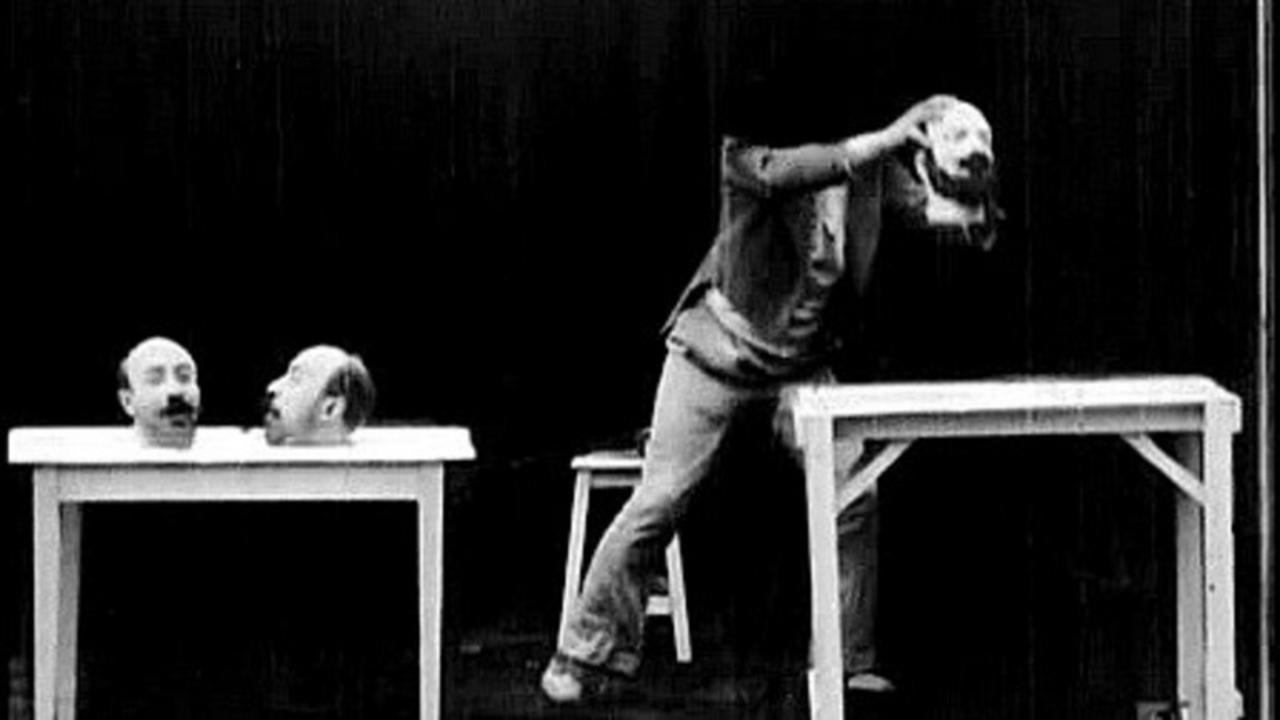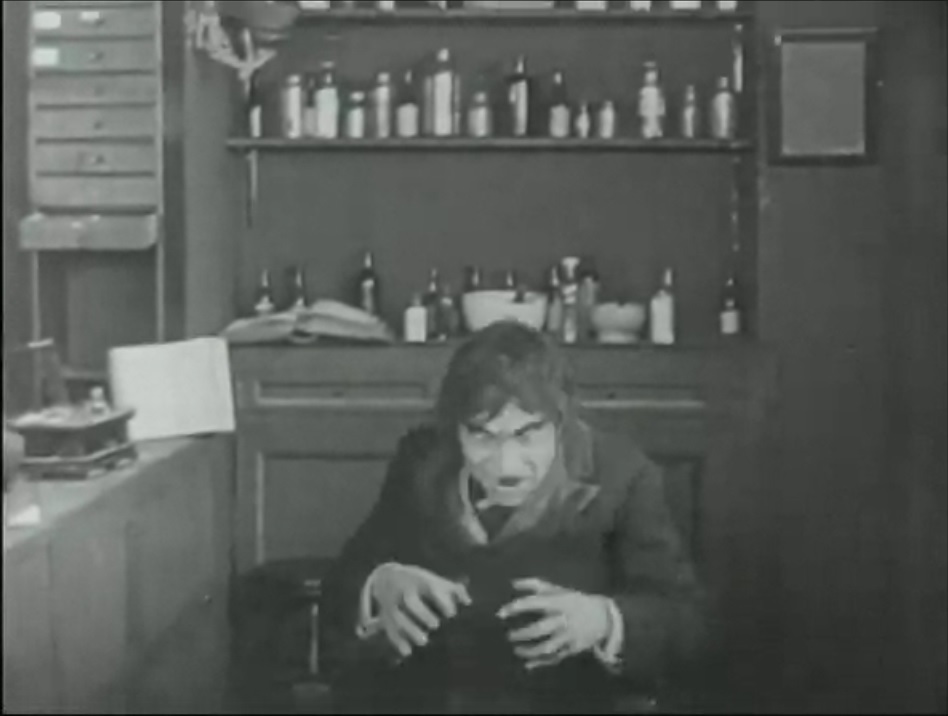Streaming Survey: Silent Horror
by Aaron Pinkston, October 26, 2017
Halloween weekend brings many horror film opportunities and there is no shortage of them streaming online—there is even an entire streaming service dedicated to the best horror films out there. But in tribute of this week's film, the fantastic The Phantom Carriage, what better way to spend this weekend with the best of creepy and spooky films from the silent era? Luckily for film fans today, almost all of the best classic silent horror films that have survived are available to stream somewhere. Here’s our recommendations for some of the best:
Georges Méliès short films [1896-1912] — available on Fandor
Any fan of silent film knows the work and importance of Georges Méliès, one of the true pioneers of the medium and the innovator of many special effects techniques. While his most famous film, A Trip to the Moon, would probably be categorized as science fiction [though there are some horror elements in there], the film magician often used his double exposures, dissolves, and splices to creep and scare. In all, Fandor has 16 short films by Méliès in their horror section and they are all delightful and full of his trademark style. A few of the highlights include: The Merry Frolics of Satan [1906, 17 minutes], a take on the Faust mythology, where a man barters with the devil for superhuman powers; The Black Imp [1905, 4 minutes], wherein an invisible menace plays tricks on an unsuspecting hotel guest; The Haunted Castle [1896, 3 minutes], which is pretty self-explanatory; and The Four Troublesome Heads [1898, 1 minute], a magic trick on film that shows Méliès removing his own head and the bizarre consequences.
Dr. Jekyll and Mr. Hyde [Lucius Henderson, 1912] — available on Fandor
Though the character may not be as beloved as Frankenstein’s monster, Dracula, or the Mummy, Dr. Jekyll and Mr. Hyde is one of the most often filmed monster stories in the history of cinema. Per the Internet Movie Database, Jekyll/Hyde have shown up on screen in 104 different films and television programs, with Lucius Henderson’s 11-minute short the third ever. There might not be anything particularly notable about this version of Dr. Jekyll and Mr. Hyde, though it is short and entertaining [did I mention it is short?]. James Cruze, who himself is a director with 74 credits, plays the dual role with the help of some fantastic makeup and a brown wig. This take’s narrative is pretty straight-forward—Dr. Jekyll decides to test the theory that particular drugs divide a man between “good” and “bad;” he then becomes addicted to letting his evil side take hold, eventually losing the power to control the metamorphosis through drugs. He meets a tragic end after he terrorizes Jekyll’s fiance and runs out of the antidote to turn him back. The short film is shot in the typically early silent style with a static camera and early editing techniques. Cruze’s portrayal of Mr. Hyde is quite fun in this context, however, as the incredible over-acting we’re used to seeing in the era is completely warranted for the crazed monster. As for the effects used to change the man into monster, Henderson uses fairly rudimentary dissolves, but they work effectively.
The Cabinet of Dr. Caligari [Robert Wiene, 1920] — available on Amazon Prime and Fandor
The OG of feature length horror filmmaking, I probably don’t have to recommend Robert Wiene’s The Cabinet of Dr. Caligari—if you’ve read this, you’ve probably already seen the film. But for those who haven’t, there is a reason why this strange and sinister film has remained in the consciousness of horror film lovers for almost 100 years. Perhaps the quintessential film from the great German Expressionist movement, The Cabinet of Dr. Caligari is as much remembered for its crazy set design and camerawork as it is for its plot. Its storytelling was innovative, however, with a narrative that was framed as a story told in flashback by its protagonist, ending with maybe the first plot twist in cinema history. The title character is our villain, a megalomaniacal sideshow hypnotist who uses a somnambulist [aka sleepwalker, but that that sound quite as scary] to kill his enemies in the night. Both Caligari and his somnambulist are expertly designed characters for the era and movement, completely grotesque and enormously expressive without the aid of dialogue. Conrad Veidt, who plays the sleepwalking Cesare, is one of the silent cinema’s most underrated actors, especially for his work in silent horror films like The Cabinet of Dr. Caligari, The Man Who Laughs [which is known to have influenced the comic book supervillain The Joker], and another film on this streaming list coming up later.
Destiny [Fritz Lang, 1921] — available on Fandor
We don’t often think of German master filmmaker Fritz Lang as being a horror director, even though many of his best films [Metropolis, M, Dr. Mabuse] lean heavily into the genre’s elements, with killers, monsters, evil hypnotists, etc. Destiny probably fits into horror in the most straight-forward way. The film would actually be the obvious Related Review for The Phantom Carriage, given their narrative and thematic similarities, but we already did that when we wrote about Intolerance last year. In the film, a young woman [the first starlet of the horror genre, Lil Dagover] is confronted by Death and presented the opportunity to save her beloved fiance. She is placed in three scenarios in three different historical time periods with these sequences playing like an anthology film while keeping its thematic thru-line. As a horror film, Destiny’s biggest achievement is the character of Death. I don’t know if this was the first to depict the malevolent force in this way, but Death’s look and presence is iconic. Played Bernhard Goetzke [who also showed up in many other Lang silent films], Death’s tall, lean, austere look is absolutely chilling and Lang’s framing and use of shadow really heightened a sense of dread.
Häxan [Benjamin Christensen, 1922] — available on Filmstruck and Amazon Prime
A true oddity for horror, Häxan is a pseudo documentary that explores the superstitions centered around witchcraft through the ages. The scientific and historic depictions of supposed witchcraft throughout Europe’s middle ages is itself fascinating, but what makes Häxan a truly memorable horror film are its horrifying recreations. Depictions of Satan and his demon brethren and stages with intricate detail with wonderful makeup effects [director Christensen takes on the starring role of the Dark Lord]. Many are so visually graphic and intense that the film was banned and censored in the United States for many years. Simply looking at screencaps from the film and you can see why—especially in the documentary form, the recreations take on a strange realism that creates a mystery of whether the rituals and torture displayed is really happening. There has never been another horror film quite like Häxan and it is a must-watch for anyone with interests in the genre. [Note that the version available on Amazon Prime is the not the original silent film, but a later production which uses footage from the original and adds spoken narration by William S. Burroughs, which is something in its own right. The original version is available to rent on Amazon and stream on Filmstruck.]
Nosferatu [F.W. Murnau, 1922] — available on Fandor, Shudder, Amazon Prime and Filmstruck
An unauthorized adaptation of Bram Stoker’s classic horror novel, the original Dracula film is also one of the scariest. Like a few other films on this list, Nosferatu showed the heights of the German Expressionist film movement through its production design, tone, and creation of its central monster. Of all the movie monsters in all of cinema, nothing tops the look of Max Schreck’s Count Orlok, a horrific and bestial representation of a character that would later become defined by a debonair charisma. The tall, seemingly impossibly skinny frame, the elongated fingers and ears, the pale and blank expression all work together for something completely unique and indelibly haunting. Seeing Orlok slowly rise from his coffin is a simple effect that is so perfectly constructed that it doesn’t feel like an effect at all. The level of its design and production works so much against a film that is so incredibly stylized—even watching the film today I get tricked into thinking this strange creature is something real. Nosferatu was directed by F.W. Murnau, one of the greatest auteurs of cinema, who has escaped the silly distinction of being a “horror director” for his work on masterpieces like Sunrise and The Last Laugh. And still his legacy has been built on Nosferatu, which may not be his best film, but is certainly his most iconic and influential.
The Hands of Orlac [Robert Wiene, 1924] — available on Shudder
The Hands of Orlac reunited director Robert Wiene and star Conrad Veidt for a creepy early monster film with an extraordinary set-up. Based on a French novel, the film involves a concert pianist who loses his hands in a terrible accident. Why not replace them with the hands of a violent murderer? What could go wrong? Well, when the pianist’s father is murdered in a similar way to the hands’ previous owner, he wonders if he could have been responsible. Though it doesn’t have the same profile as other contemporary monster movies, The Hands of Orlac has been re-made twice [once starring Peter Lorre, once starring Christopher Lee]. It is that strange, fantastical set-up, however, that has lived on in horror with dozens of imitators and re-imaginings. Stylistically, the film was made in that trademark Expressionist style bordering on early melodrama, with the set dressing and tone mirroring the tortured psyche of its main character. Veidt is extraordinarily good in the lead role, too, much more expressive than his signature performance as Cesare the somnambulist allowed him to be.
The Phantom of the Opera [Rupert Julian, 1925] — available on Fandor, Shudder and Amazon Prime
Maybe my personal favorite when it comes to silent horror, The Phantom of the Opera showcases an iconic performance from the “man of a thousand faces” Lon Chaney, creating one of the great monsters in cinema history. The story is probably best known today as a musical but that doesn’t take away anything from this silent version. The fated romance between the ghost living in the shadows of an opera house and the newest ingenue [Mary Philbin] is equal parts tragically sad and suspenseful. Like many of the best horror films of this era, the viewer’s sympathies change suddenly between sadness and terror. The Phantom of the Opera’s thematic model was lifted and popularized by later Universal Studios films like Frankenstein and Freaks, where the monster wasn’t often monstrous or the most dangerous character, but the unforgiving society that was spurred by hatred and fear for the different. In his signature performance, Chaney is remarkable, providing real humanity to the monster despite being cloaked in a mask and makeup. His final reveal, where his beloved takes off his mask, is one of the first great shocks of cinematic horror and remains the height of movie makeup design.









